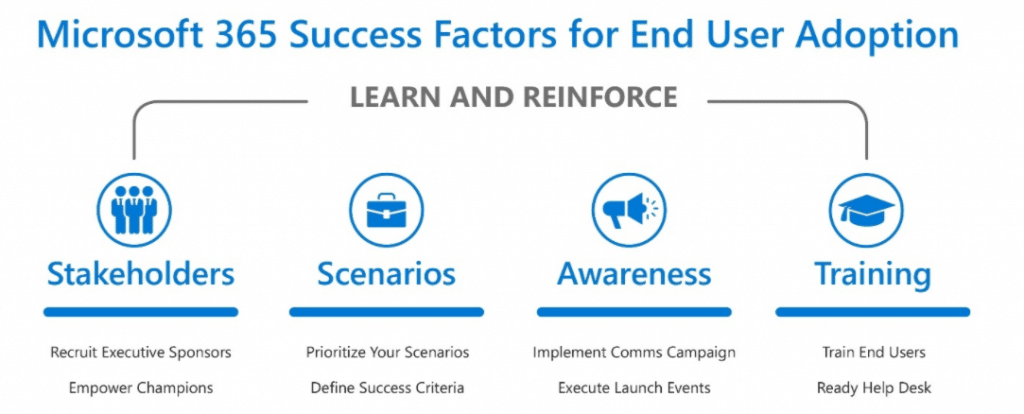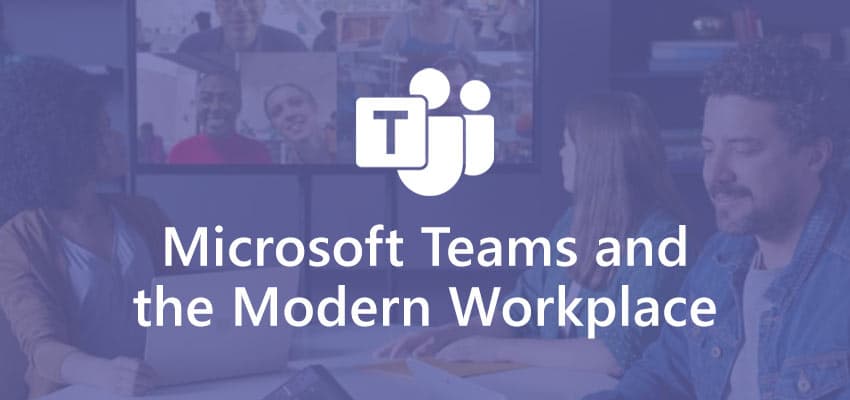

The way that people connect in their personal and professional lives has fundamentally changed in the last few years. People now expect to be able to get things done at work in the same way. Microsoft 365 allows your organisation to become more connected, collaborative, and structured in how work gets done, however, this can only be done if you take the people in your organisation on that journey with you. This article is for organisations looking for the most effective ways to leverage their investment in Microsoft 365.
Achieving success with Microsoft 365 means making sure it helps everyone in your organisation achieve more with their work. Before rolling out Microsoft 365, take a step back and think about why your organisation purchased it in the first place. Was it led by specific technical requirements, as part of the IT upgrade cycle, or did you discover specific needs within the business?
Driving adoption comes from the understanding of your business challenges and addressing these with Microsoft 365 solutions. It is about ensuring that people across your organisation understand the benefits and embrace the solutions you provide. People will often resist technology driven change out of fear of the unknown or not understanding why the change is being made and how it will help them. This resistance can be overcome with a focus on four success factors: Stakeholders, Scenarios, Awareness, and Training. By investing in all four areas you will help your end users adopt Microsoft 365 and your organisation realise the value of it:

Your Microsoft 365 rollout is not just about implementing new technologies, rather it’s part of a broader transformation to achieve the business outcomes that matter most to your organisation. Many companies adopt Microsoft 365 to enable a new culture of work that empowers their employees to be creative and work together, securely. Transforming to this new culture of work requires buy-in from across the organisation. There are two stakeholder groups whose participation is critical to getting this buy-in:
The true measure of success for your Microsoft 365 adoption, like any change or new technology, will be the value realised by your organisation from its investment. Your opportunity with Microsoft 365 is to enable the different Lines of Business and departments in your organisation to realise important business outcomes. This requires identifying and prioritising scenarios, which are the different ways people and teams in your organisation can use the capabilities of Microsoft 365 to achieve their goals.
So, how can you work with your business stakeholders to identify relevant scenarios for their teams to adopt? At its most basic level it’s about identifying what the team wants to accomplish, how they can use the technology to accomplish their goal, and what the expected impact of the Scenario is. To help you get started, check out the Microsoft 365 productivity library, where you can discover new scenarios based on your industry and different functional departments.
Now that you have identified and prioritized your scenarios, it’s time to create internal excitement about the scenarios and ready end users to successfully adopt them. We are all too familiar with how hard it is to get people to change. Therefore, it’s important your communication and training efforts are positioned in the context of what your end users care about most, what’s in it for them. An effective way of doing this is to tailor your communications and training around the scenarios you identified and prioritised earlier in your planning efforts.
Like any change, it’s important to reinforce it to ensure end users sustain their adoption of Microsoft 365 and the new culture of work it brings. Don’t think of your awareness and training execution as a one-time event, rather it should cover pre-launch, launch, and post-launch.
Create internal awareness and excitement:
To drive sustained adoption, users must be aware of and excited for Microsoft 365. This means doing internal communications to promote Office 365 and engagement events. Have a senior leader in the business be the face of your awareness campaign to validate the importance of the organisation adopting Microsoft 365 and getting everyone onboard.
Enable end users to be successful with Microsoft 365:
Training end users should take on multiple forms to accommodate different learning styles, geographical barriers, and any constraints you face. Use your champions to help supplement your training plan, they are very effective at helping ready your end users.
Now that we’ve reviewed all four of the success factors for driving Microsoft 365 adoption – Stakeholders, Scenarios, Awareness and Training, your question may be what’s next? Spanish Point Technologies will work with you to build your Success Plan and help you implement these four success factors. Contact us now to get started.

Be more productive wherever you are and kick-start your digital transformation by signing up to our bootcamp!